
Rabbit Anti-PRPH2 antibody
Peripherin-2; PRPH2; PRPH2_HUMAN; Retinal degeneration slow protein; Tetraspanin-22; Tspan-22.
View History [Clear]
Details
Product Name PRPH2 Chinese Name 外周蛋白2抗体 Alias Peripherin-2; PRPH2; PRPH2_HUMAN; Retinal degeneration slow protein; Tetraspanin-22; Tspan-22. Research Area Neurobiology Signal transduction Cytoskeleton The cell membrane蛋白 Immunogen Species Rabbit Clonality Polyclonal React Species Mouse, (predicted: Human, Rat, Chicken, Dog, Cow, Horse, Sheep, ) Applications WB=1:500-2000 ELISA=1:5000-10000 IHC-P=1:100-500 IHC-F=1:100-500 ICC=1:100-500 IF=1:100-500 (Paraffin sections need antigen repair)
not yet tested in other applications.
optimal dilutions/concentrations should be determined by the end user.Theoretical molecular weight 39kDa Cellular localization The cell membrane Form Liquid Concentration 1mg/ml immunogen KLH conjugated synthetic peptide derived from human PRPH2: 131-230/346 Lsotype IgG Purification affinity purified by Protein A Buffer Solution 0.01M TBS(pH7.4) with 1% BSA, 0.03% Proclin300 and 50% Glycerol. Storage Shipped at 4℃. Store at -20 °C for one year. Avoid repeated freeze/thaw cycles. Attention This product as supplied is intended for research use only, not for use in human, therapeutic or diagnostic applications. PubMed PubMed Product Detail May function as an adhesion molecule involved in stabilization and compaction of outer segment disks or in the maintenance of the curvature of the rim. It is essential for disk morphogenesis.
Function:
May function as an adhesion molecule involved in stabilization and compaction of outer segment disks or in the maintenance of the curvature of the rim. It is essential for disk morphogenesis.
Subunit:
Homodimer; disulfide-linked. Probably forms a complex with a ROM1 homodimer. Other proteins could associate with this complex in rods. Interacts with MREG.
Subcellular Location:
Membrane; Multi-pass membrane protein.
Tissue Specificity:
Retina (photoreceptor). In rim region of ROS (rod outer segment) disks.
DISEASE:
Defects in PRPH2 are the cause of retinitis pigmentosa type 7 (RP7). RP leads to degeneration of retinal photoreceptor cells. Patients typically have night vision blindness and loss of midperipheral visual field. As their condition progresses, they lose their far peripheral visual field and eventually central vision as well.
Defects in PRPH2 are a cause of retinitis punctata albescens.
Defects in PRPH2 are a cause of adult-onset vitelliform macular dystrophy (AVMD). AVMD is a rare autosomal dominant disorder with incomplete penetrance and highly variable expression. Patients usually become symptomatic in the fourth or fifth decade of life with a protracted disease of decreased visual acuity.
Defects in PRPH2 are a cause of patterned dystrophy of retinal pigment epithelium (PDREP). Patterned dystrophies of the retinal pigment epithelium (RPE) refer to a heterogeneous group of macular disorders. Three main types of PDREP have been described: reticular (fishnet-like) dystrophy, macroreticular (spider-shaped) dystrophy and butterfly-shaped pigment dystrophy.
Defects in PRPH2 are a cause of choroidal dystrophy central areolar type 2 (CACD2). It is a disorder which affects the posterior pole of the eye, and early lesions consist of a non-specific area of granular hyperpigmentation at the fovea. The characteristic sign of the disorder, a zone of atrophy that develops in the macula of the eye and involves the retinal pigment epithelium and the choriocapillaris, occurs several decades after onset.
Similarity:
Belongs to the PRPH2/ROM1 family.
SWISS:
P23942
Gene ID:
5961
Database links:Entrez Gene: 5961 Human
Entrez Gene: 19133 Mouse
Omim: 179605 Human
SwissProt: P23942 Human
SwissProt: P15499 Mouse
Unigene: 654489 Human
Product Picture
Bought notes(bought amounts latest0)
No one bought this product
User Comment(Total0User Comment Num)
- No comment



 +86 571 56623320
+86 571 56623320
 +86 18668110335
+86 18668110335

